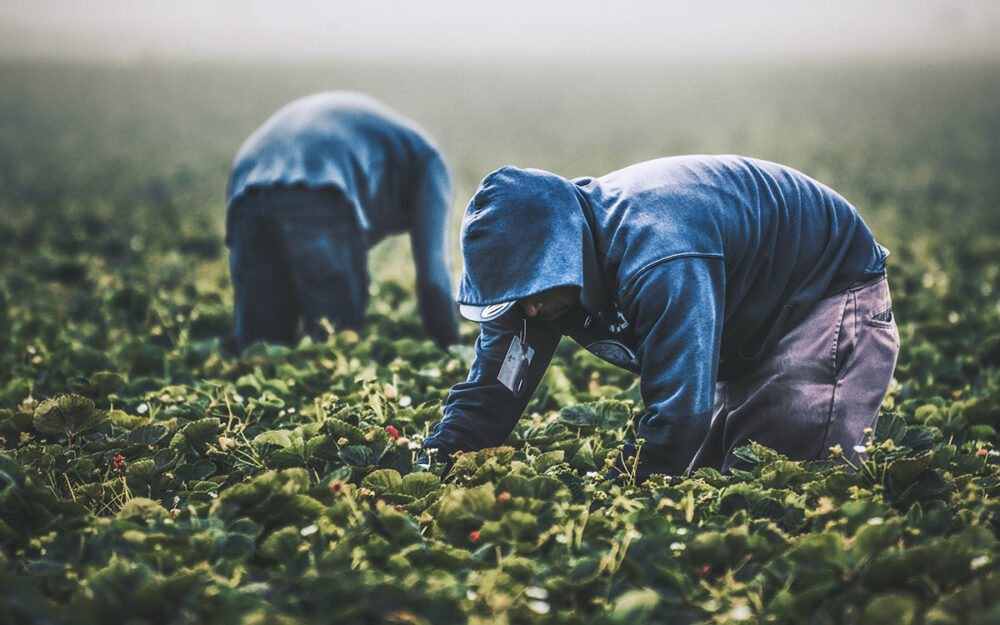
“All they care about is the harvest,” Gracida Daleyza, a farmworker and mother of two young disabled children, told Lookout Santa Cruz. Daleyza was speaking about the employers at her work picking strawberries, seasonal labor which can include low pay and long hours amid punishing heat, and other difficult physical conditions.
Farmworkers across the United States face another danger, one they may bring home to their families as well: pesticides. A new study finds that farmworkers—and their families, who often live or stay near fields or orchards—are in continued danger of pesticide exposure.
“You just have to put on a mask and take care of yourself the best you can.”
Exposed and At Risk: Opportunities to Strengthen Enforcement of Pesticide Regulations for Farmworker Safety was recently released by the Center for Agriculture and Food Systems at Vermont Law and Graduate School, in partnership with the nonprofit Farmworker Justice. According to the report, about one billion pounds of pesticide are applied to crops each year, regularly exposing farm workers to high levels of chemicals. The report describes these exposures as “exacerbated by insufficient worker training and frequent improper handling and application.”
A Dangerous, Sometimes Deadly Job
Farm work in the United States is increasingly dangerous, intensified by the impacts of climate change: soaring temperature, wildfires, and air pollution.
After moving to the San Joaquin Valley in California, dairy worker José Federico Sierra saw his asthma worsen; his sister Antonia Sierra Martínez, a community health worker, developed asthma too. As KQED reported on Sierra’s work, come wildfire haze or polluted air, “no matter what…his job keeps him outdoors.”
Sierra told KQED, “You just have to put on a mask and take care of yourself the best you can.”
But a mask won’t shield workers from dangerously high temperatures, a threat that continues to increase as climate change heats up the globe. Based on data from the Bureau of Labor Statistics, environmental heat exposure killed an average of 43 farmworkers per year between 2011 and 2021.
In July 2023, NPR reported on one of President Joe Biden’s campaign promises: to establish heat protections for farmworkers. “Two years later—as another heat dome causes deaths among farm workers and others—it is still not done,” NPR wrote. Doug Parker, assistant secretary for Occupational Safety and Health at the Labor Department, told NPR that he believes the deaths reported to Bureau of Labor Statistics are a low estimate. Farmworker deaths continued to be underreported.
PBS characterized deaths due to heat as “historically hard to track.” Each state handles heat deaths differently; there are no nationwide standards for reporting them. When deciding a cause of death, aspects like temperature are often overlooked. “The only way to definitively link a death to heat is if the person’s body temperature is recorded. And for that to happen, the person has to be found alive or immediately after death,” according to PBS. Sometimes heat deaths are misclassified as deaths from natural causes.
Sign up for our free newsletters
Subscribe to NPQ's newsletters to have our top stories delivered directly to your inbox.
By signing up, you agree to our privacy policy and terms of use, and to receive messages from NPQ and our partners.
A Lack of Consequences
According to the report, “surprise” inspections are rarely a surprise.
As heat continues to sicken and claim the lives of farmworkers, those who work outdoors in fields, orchards, ranches, and farms also face danger from the very crops they pick and tend. Building upon a 2021 report from the Vermont Law and Graduate School’s Center for Agriculture and Food Systems, the new 2023 report finds farmworkers still remain vulnerable to pesticide exposure. The report also uncovered that compliance with existing pesticide enforcement laws, meant to protect farmworkers, is “woefully low.”
For example, farms are supposed to be inspected randomly for proper pesticide usage and precautions, but according to the report, “surprise” inspections are rarely a surprise. Many farms seem to have a culture of “warning each other when routine inspection ‘sweeps’ are occurring.” And such unannounced visits can end up creating operational problems for inspectors because the documents they need from farms may not be readily available or organized, leading to delays.
Even when serious violations regarding pesticides are found, farms rarely face appropriate consequences. Steep fines or risks to a farm’s license could be deterrents to disregarding safety protocol, but the report tracked a federal regulation called the Worker Protection Standard (WPS), discovering “more than half of all WPS violations result in no enforcement action. Of the violations that do result in enforcement actions, half of those result in only a warning.”
Being clear about what chemicals are sprayed on crops is an important part of keeping workers safe and treating workers should accidents occur, but some states—including Florida, Illinois, and Washington—do not require farms to disclose lists of pesticides used. Illinois also does not mandate that medical providers report suspected cases of pesticide exposure.
Impacting Families
Farmworkers can come into contact with pesticides by absorbing them through their skin or breathing them in, and throughout the processes of planting, weeding, irrigating, harvesting, and processing crops.
Pesticides can also be transferred onto clothing. The Pesticide Action Network reported that “pesticides carried from field to home on parents’ clothing and skin puts farmworker children at risk,” exacerbating an already unhealthy situation for workers’ families, as many live in or close by chemically treated fields.
Multiple studies have tracked the impact of pesticides on the health of workers, their children, and their families. Exposure to chemicals routinely used on crops can lead to both acute and chronic conditions. One 2020 study linked pesticide exposure to “neurological, endocrine, psychological, immunological, respiratory, hematological, skin, kidney and liver issues, as well as fetal malformation.” According to another study from 2021, little research has been done specifically tracing the impact of pesticides from farm work on Latinx children.
A Racial Justice Issue
“Without question, farmworkers are essential to our food system.”
As reported by the National Center for Farmworker Health, 73 percent of agriculture workers were born outside of the United States, with 69 percent born in Mexico. Farmworkers’ vulnerable immigration status can make it difficult for them to report pesticide violations, exposures—or to feel safe enough to seek medical treatment when accidents do occur. As the new Center for Agriculture and Food Systems report notes, these farmworkers are “completely dependent on their employers, meaning they are very unlikely to raise issues related to working conditions for fear of deportation.” With a workforce overwhelmingly made up of people of color, pesticide usage in farm work is very much a racial justice issue.
The report calls for a strengthening of the pesticide law enforcement already in place, along with recommendations for states such as implementing mandatory reporting requirements and increasing the fines for WPS violations. As the report states, “Without question, farmworkers are essential to our food system. To ensure that they receive sufficient health and safety protection, significant social, cultural, and political conditions must be addressed. At a minimum, the regulatory system that has the potential to protect them should not be working against them.”










